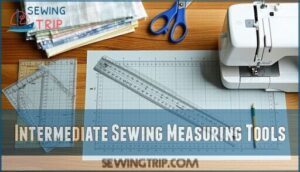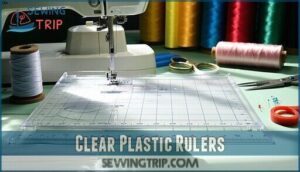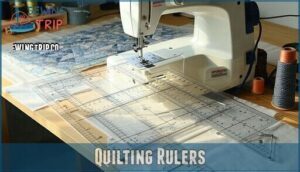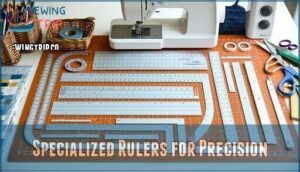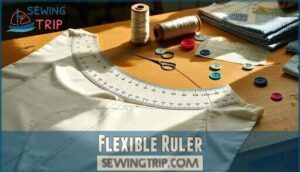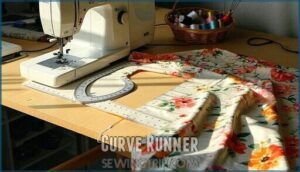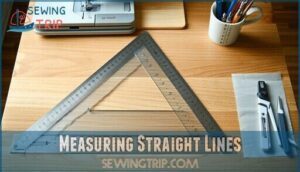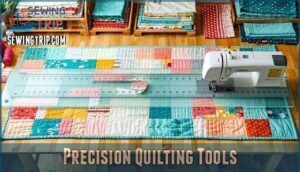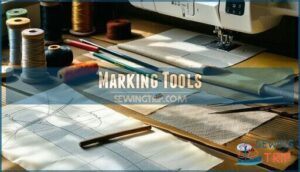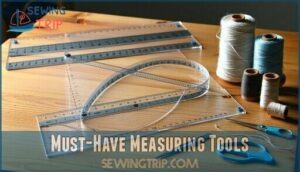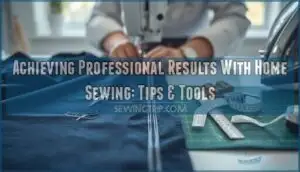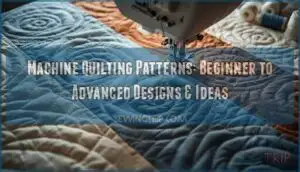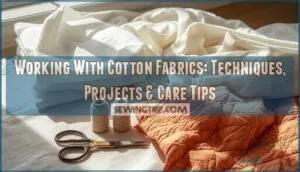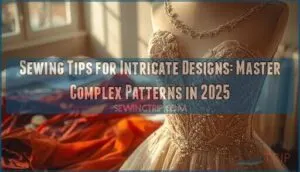This site is supported by our readers. We may earn a commission, at no cost to you, if you purchase through links.
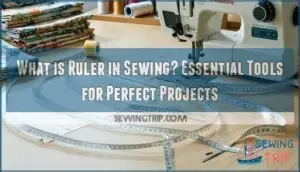 A ruler in sewing is your precision tool for measuring fabric, marking seam allowances, and creating accurate patterns.
A ruler in sewing is your precision tool for measuring fabric, marking seam allowances, and creating accurate patterns.
You’ll find specialized sewing rulers that differ from school rulers—they’re often clear plastic so you can see through fabric layers, feature multiple measurement units, and come in various shapes like curves and L-squares.
These tools handle everything from measuring your waist for a perfect fit to marking quarter-inch seam allowances on delicate silk.
Whether you’re using a flexible measuring tape for body measurements or a rigid quilting ruler for straight cuts, rulers eliminate the guesswork that turns ambitious projects into frustrating failures.
The secret lies in choosing the right ruler for each specific task, which is a crucial step in ensuring your sewing projects turn out as envisioned, making it a key part of the sewing process to achieve a perfect fit.
Table Of Contents
Key Takeaways
- You’ll need four essential rulers to start sewing: a flexible measuring tape for body measurements, a rigid yardstick for long fabric pieces, a clear plastic ruler for seeing through fabric layers, and a small quilting ruler for precise seam allowances.
- Choose specialized rulers based on your project type—L-shaped rulers create perfect right angles for pattern drafting, French curves shape necklines and armholes, and quilting rulers with grid markings ensure accurate cutting for patchwork.
- Clear plastic and acrylic rulers offer superior visibility through fabric, letting you align patterns and see grain lines while measuring, which eliminates guesswork and prevents costly cutting mistakes.
- You can’t replace measuring tapes with rulers completely since tapes handle curves, body measurements, and long distances that rigid rulers can’t accommodate, making both types essential for comprehensive sewing accuracy and using a clear plastic ruler.
Essential Measuring Tools for Sewing
You’ll need four essential measuring tools to start your sewing journey with confidence and accuracy.
These basic rulers form the foundation of precise cutting, marking, and pattern work that separates amateur projects from professional-looking garments.
Measuring Tape
Your measuring tape stands as the most vital tool in your sewing arsenal, enabling precise body measurements and fabric calculations. This flexible tool guarantees accuracy across all your projects.
- Choose fiberglass or vinyl tapes for material durability and flexibility around curves
- Select designs with large, clear markings for readability in both metric and imperial units
- Look for ergonomic design features like easy-grip cases and retraction mechanisms
- Test tape accuracy by comparing measurements against known standards before use
Quality measuring tapes feature reinforced metal end tabs that prevent fraying and maintain measurement precision over time. The flexibility allows you to contour around body curves while the sturdy construction withstands frequent use.
Professional sewers invest in measuring tapes with reinforced ends that bend around curves while delivering unwavering accuracy through years of dedicated use.
For ideal results, consider the essential sewing tools to enhance your efficiency. Portable designs with smooth retraction mechanisms make measuring efficient, whether you’re checking seam allowances or taking body measurements. Investing in a reliable measuring tape with clear sewing measurements creates the foundation for professional results in every sewing ruler application.
Yardstick
When measuring tape reaches its limits, you’ll reach for a yard stick. This versatile measuring tool excels at fabric alignment across long measurements, ensuring your cutting guidance stays true.
Mark hems on lengthy garments without wrestling with shorter rulers. A sturdy yard stick maintains straight lines for trouser legs and skirt panels, making hem marking effortless.
Its rigid structure won’t bow under fabric weight, delivering precise measurements every time. From pattern drafting to final construction, this sewing ruler handles versatile applications that demand accuracy over distance.
Many sewers find it useful to buy sewing yardsticks online, utilizing their sewing yardsticks for various tasks, and many also appreciate the value of a versatile measuring tool.
Clear Ruler
With perfect precision at your fingertips, a clear ruler becomes your trusted companion for accurate measurements and straight lines.
Made from durable acrylic material, transparent rulers let you see through to your fabric, ensuring perfect pattern alignment without guesswork.
The grid markings serve as your roadmap, helping you mark seam allowances with confidence and cut fabric pieces that fit together flawlessly.
This essential measuring tool offers fabric visibility that opaque rulers simply can’t match.
You can find a variety of options online.
Whether you’re a beginner or seasoned seamstress, adding this versatile sewing tool to your collection guarantees professional results every time you measure and cut.
Small Quilting Ruler
Small quilting rulers pack big precision into compact designs.
You’ll love their portability for travel projects and workshops.
These transparent rulers, typically 6-12 inches long, feature acrylic thickness that won’t bend under pressure.
Their miniature accuracy shines in block sizing, where every quarter-inch matters.
Perfect seam allowance markings eliminate guesswork, while clear grids help align fabric grain.
These are available at various online retailers.
Whether you’re piecing tiny hexagons or trimming flying geese, these measuring tools deliver professional results in tight spaces, making them ideal for precision quilting.
Intermediate Sewing Measuring Tools
As you advance in sewing, intermediate measuring tools become essential for achieving professional-quality results and tackling more complex projects.
These specialized rulers help you create precise curves, measure intricate details, and maintain consistent accuracy throughout your work.
Sewing Gauge
Everyone needs precise tools when creating professional-looking garments, and a sewing gauge delivers unmatched accuracy for small measurements.
This compact measuring tool features a sliding marker that locks at your desired measurement, making it perfect for consistent seam allowance marking and hem depth calculations.
You’ll find it invaluable for buttonhole placement, ensuring each opening sits exactly where it should.
When working with narrow seams or creating uniform pleat measurement, this measuring gauge eliminates guesswork completely.
Unlike bulky measuring tools, a seam gauge fits comfortably in your hand while providing the precision needed for detailed work.
It’s the measuring tool that transforms good sewers into great ones.
French Curve
French curves—those elegant, flowing rulers with multiple curves—transform your pattern drafting from guesswork into precision.
Transform pattern drafting chaos into flowing precision with every graceful curve.
These transparent templates excel at Curve Applications and Drafting Necklines, making Armhole Shaping effortless. As essential sewing tools for dressmaking ruler work, they create smooth Seam Curves that elevate your garments.
- Trace perfect armholes using the tool’s varied curve radii
- Draft elegant necklines that flow naturally around the neck
- Shape sleeve caps with professional smoothness
- Create precise darts for fitted silhouettes
- Blend pattern alterations seamlessly into existing curves
While Flexible Alternatives exist, the french curve remains the gold standard for sewing curves requiring consistent, reproducible results.
Flexible Curved Ruler
While French curves handle standard pattern shapes, you’ll find flexible curved rulers bend to match any contour on your garment.
These versatile tools excel at contoured measurements for awkward shapes like hips, necklines, and armholes.
Simply mold the flexible curve to your desired shape, then trace for pattern adjustments.
Whether you’re working on garment fitting challenges or exploring design versatility, these curved rulers outperform rigid French curve and hip curve tools for custom sewing curves.
Some curved rulers utilize aviation-grade aluminum for superior strength.
Versatile Rulers for Sewing
You’ll find clear plastic rulers and quilting rulers incredibly useful for multiple sewing tasks beyond basic measuring.
These transparent tools let you see exactly where you’re cutting or marking, while quilting rulers feature helpful grid systems that make quick work of cutting strips and maintaining perfect seam allowances, which is an essential task for achieving perfect seam.
Clear Plastic Rulers
Clear plastic rulers bring remarkable advantages to your sewing workspace. Their Acrylic Clarity and Light Transmission let you see fabric patterns underneath while maintaining sewing precision.
These transparent tools eliminate guesswork when aligning pattern pieces or measuring seam allowances. The Markings Durability and Scratch Resistance guarantee measurements stay crisp through countless projects.
A quality plastic ruler withstands frequent handling while providing consistent sewing accuracy. Many feature gridlines that create a built-in ruler guide system for perfect alignment. Heat Resistance means they won’t warp near your iron, making them reliable workspace companions.
Whether you’re checking hem depths or guaranteeing straight cuts, these versatile tools adapt to various sewing measuring tasks. For superior results, consider rulers with non-slip features to prevent movement during cutting.
Here’s what makes sewists love their clear plastic rulers:
- You’ll never lose track of fabric grain lines again
- Mistakes become impossible when you can see exactly where you’re measuring
- Your confidence soars knowing every measurement is spot-on
These dependable tools transform uncertainty into precision, making every stitch count.
Quilting Rulers
When you’re ready to elevate your quilting game, quilting rulers become your precision partners.
These specialized tools feature acrylic thickness that provides durability while allowing clear visibility through fabric layers.
| Feature | Benefit | Popular Size |
|---|---|---|
| Ruler Markings | Crystal-clear measurements prevent costly mistakes | 6" x 24" |
| Non-Slip Grips | Keeps ruler steady during cutting motions | 12.5" x 12.5" |
| Cutting Angles | Creates perfect 45° and 60° cuts effortlessly | 8" x 14" |
The shape variety available transforms complex quilting tasks into manageable steps.
Whether you’re using a plastic ruler for basic cuts or a metal ruler for heavy-duty work, these ruler guides maintain consistent accuracy.
A quality scale ruler eliminates guesswork, while specialized options like Dresden plate rulers create stunning curved segments.
From simple squares to intricate star patterns, quilting rulers open up creative possibilities that seemed impossible before.
Specialized Rulers for Precision
When you need precision beyond basic measuring, specialized rulers become your secret weapons for professional-quality results.
These targeted tools tackle specific sewing challenges that standard rulers can’t handle, from perfect right angles to smooth curves and exact quilting measurements.
L-Shaped Ruler
When building patterns from scratch, an L-shaped ruler becomes your blueprint for accuracy.
This tailor ruler guarantees perfect grainline alignment by letting you position fabric’s lengthwise and crosswise grains at precise 90-degree angles.
You’ll achieve flawless angle accuracy every time you square your fabric pieces against its perpendicular edges.
Pattern drafting becomes simpler when you use this grading ruler to maintain consistent seam allowance measurements.
Whether you’re creating sleeve curves or checking collar placement, the Lsquare ruler keeps everything geometrically sound.
This tool transforms guesswork into precision, helping you create garments that fit like they were custom-made for your body.
French Curve Ruler
Crafting graceful curves becomes effortless when you master the French curve ruler’s unique design.
This specialized dressmakers curve ruler features multiple arc combinations that help you create professional-looking garments with precision and confidence.
- Curve applications: Perfect armholes, necklines, and sleeve caps with smooth passages
- Pattern alterations: Modify existing patterns while maintaining proper proportions and fit
- Seam shaping: Create elegant princess seams and curved darts for flattering silhouettes
- Design aesthetics: Achieve couture-level finishing in your custom garment construction
Tool mastery with this curved ruler elevates your sewing from amateur to professional quality.
Square Quilting Scale
Every square quilting scale transforms your patchwork projects into precision masterpieces. These essential sewing supplies feature grid systems with quarter-inch markings, enabling perfect block accuracy for squares ranging from 3 to 16 inches.
You’ll achieve flawless angle precision while trimming half-square triangles and flying geese shapes. This indispensable sewing tool among pattern drafting tools and measuring gauges guarantees your fabric cutting maintains consistent dimensions.
Eliminating those frustrating "almost square" blocks that throw off entire quilt designs is a key benefit of using these scales, ensuring that your fabric cutting maintains consistent dimensions.
Measuring Curved Lines
When you’re working with curved seams, necklines, or sleeve caps, measuring those flowing lines accurately becomes your next challenge.
Two specialized tools make this task straightforward: flexible rulers that bend to match any curve, and curve runners that roll smoothly along curved edges to capture precise measurements.
Flexible Ruler
Flexibility becomes your secret weapon when tackling the trickiest sewing challenges.
A flexible curve ruler bends and shapes to match any contour, making dart manipulation and waistline shaping incredibly precise. Unlike rigid sewing rulers, this tool adapts to your project’s needs.
This versatile ruler excels at:
- Contoured measurement around curved seams and irregular shapes
- Bending precision for accurate dart placement and sleeve adjustments
- Seam allowance marking on both straight lines and curved lines.
Made from durable plastic, it won’t snap under pressure but maintains its flexibility through countless projects.
You’ll find it invaluable for measuring armholes, hip curves, and necklines where traditional rulers fall short. The flexible curve ruler bridges the gap between your measuring tape and French curve, offering precision where eyeballing simply won’t cut it.
Curve Runner
While measuring curved seams can feel like wrestling with a stubborn zipper, a curve runner transforms this challenge into smooth sailing.
This handheld measuring wheel rolls effortlessly along pattern curves, delivering rolling accuracy that straight rulers simply can’t match.
Here’s what makes curve runners essential sewing tools:
- Compact Design – Small enough to fit in your sewing kit while handling both curved lines and straight lines with precision
- Efficient Measuring – One smooth roll captures measurements faster than fumbling with flexible curve ruler or measuring tape
- Versatile Application – Perfect for armholes, necklines, and hip curves where traditional sewing rulers fall short
Unlike a rigid buttonhole ruler, this tool adapts to any curve’s shape.
The rolling wheel mechanism guarantees consistent contact with your pattern, eliminating the guesswork that plagues other measuring methods.
Professional tailors swear by curve runners for comparing seam lengths and verifying pattern accuracy.
When your project demands precision on curved seams, this compact measuring tool delivers reliable results every time.
Measuring Straight Lines
When you’re measuring straight lines for your sewing projects, you’ll rely on three essential rulers that make precision effortless.
Clear rulers, yardsticks, and L-square rulers guarantee your cuts stay true and your seams align perfectly every time, which is crucial for achieving professional-looking results with precision.
Clear Rulers
Clear rulers transform chaotic fabric cutting into precise geometry.
Transparent acrylic rulers let you see fabric patterns and grain lines while marking seam allowances and darts.
The transparency benefits make pattern visibility effortless, ensuring accuracy alignment every time.
| Ruler Length | Best For | Key Feature |
|---|---|---|
| 6-inch | Small details, curves | Portable precision |
| 12-inch | Straight seams, hems | Standard workhorse |
| 18-inch | Long cuts, quilting | Extended reach |
These sewing tools guide fabric marking with surgical precision.
Clean them gently with soap—cloudy rulers defeat their purpose.
Your sewing dimensions depend on these transparent allies for professional results.
Yardsticks
A yardstick transforms how you approach large sewing projects, bringing precision to measurements that tape measures can’t handle alone.
Yardstick Materials like wood, aluminum, or plastic each offer different benefits for your sewing tools guide needs.
Quality aluminum models provide durability while remaining lightweight for extended use.
Consider these game-changing advantages:
- Measuring Wide Fabrics: You’ll accurately gauge curtain panels and quilting backings without wrestling with flexible tape
- Length Accuracy: Hemlines stay perfectly even across garments, eliminating those frustrating crooked results
- Alternative Uses: Double-check pattern pieces and create straight cutting guides for multiple fabric layers
For Storage Solutions, look for yardsticks with hanging holes or consider wall-mounted racks.
When measuring sewing dimensions beyond a yardstick’s reach, you can align multiple rulers end-to-end.
Pair your yardstick with shorter rulers for detail work, creating a thorough measuring system that handles both sewing lengths and sewing widths with confidence.
L-Square Ruler
L-square rulers outrank yardsticks when you need true precision for pattern drafting.
This T-square sewing tool features two perpendicular arms that create perfect right angles every time.
You’ll achieve flawless grainline alignment and fabric squaring with its 90-degree construction, making it superior to an adjustable ruler for geometric accuracy.
The perpendicular lines you draw will be mathematically perfect, ensuring your patterns maintain proper proportions.
Unlike a hip curve ruler that handles curves, this tool excels at straight-line work.
Whether you’re drafting sleeves or marking pocket placements, the L-square eliminates guesswork from your measurements, delivering the control serious sewers demand.
It ensures that your sewing projects have perfect right angles and flawless grainline alignment, making it an essential tool for precise sewing.
Precision Quilting Tools
Quilting demands precision that starts with acrylic rulers designed specifically for fabric cutting. These transparent powerhouses work seamlessly with rotary cutters, creating clean, accurate cuts that’ll make your blocks sing in harmony.
The secret lies in mat pairing – matching your ruler to a cutting mat that won’t dull your blade or throw off measurements. Template accuracy becomes your best friend when you’re dealing with complex patterns.
Modern quilters swear by rulers featuring laser guides and non-slip grips that prevent those heart-stopping moments when fabric shifts mid-cut. While your trusty tape measure handles body measurements, quilting rulers tackle the nitty-gritty of fabric precision.
A 6″ or 6.5″ by 24″ ruler is ideal for cutting strips from fat quarters.
Consider these game-changers for your quilting arsenal:
- Adjustable rulers that expand from 6" to 24" for versatile cutting needs
- Hip curve rulers for shaping those tricky curved seams in garments
- Rulers with both metric measurements and imperial measurements for pattern flexibility
- Non-slip surfaces that grip fabric like they mean business
Quality rulers transform chaotic cutting sessions into smooth, predictable processes where every measurement counts.
Marking Tools
Beyond measuring lines and curves, marking tools transform your sewing vision into reality.
These precision instruments create temporary guides that disappear after construction, leaving only perfectly placed details behind.
Fabric Markers offer the most versatility for everyday projects.
Water-soluble versions vanish with a damp cloth, while air-erasable types fade within 24-48 hours.
Choose fine-tip markers for delicate fabrics and bold tips for heavy materials.
Tracing Wheels paired with carbon paper transfer intricate pattern details onto fabric.
The serrated wheel creates dotted lines that follow curved seams, dart placements, and construction markings with remarkable accuracy.
Tailors Chalk remains the classic choice for temporary marking.
Traditional triangular chalk works well on most fabrics, while mechanical chalk pencils provide consistent line width for detailed work.
Marking Pencils designed specifically for fabric offer precision without permanent marks.
Silver pencils show clearly on dark fabrics, while white versions work perfectly on colored materials.
For dark fabrics, consider using light colored markers for ideal visibility.
Awls create precise holes for button placement and eyelet positioning.
These sharp tools punch through multiple fabric layers, ensuring perfectly aligned closures every time.
Must-Have Measuring Tools
Anyone serious about sewing knows that having the right sewing essentials transforms your work from guesswork to precision.
Your sewing tools list should start with a quality measuring tape—look for tape durability with reinforced edges and clear ruler markings that won’t fade over time.
You’ll need both rigid and flexible rulers for fabric measurement success.
Invest in high-quality clear acrylic rulers with excellent clear visibility, like those from Omnigrid or Creative Grids.
These sewing measuring workhorses feature precise grid lines perfect for quilting squares and seam allowances.
Don’t overlook yardstick uses—they’re essential for drawing straight grain lines and cutting long pieces accurately.
Your sewing tool recommendations should include various sizes: mini rulers for detailed patchwork, flexible curves for sleeves and necklines, and large quilting rulers with quarter-inch markings.
Mix materials too—metal edges stay sharp, while flexible plastic bends around curves.
For precise measurements, consider tools that utilize digital angle gauges.
With these sewing measuring fundamentals within reach, you’ll cut and construct with the confidence that comes from knowing every measurement is spot-on.
Frequently Asked Questions (FAQs)
What is a ruler used for in sewing?
Every sewist knows that precise measurements make or break your project.
You’ll use rulers to measure fabric lengths, guide straight cuts, verify seam allowances, and draft accurate patterns with professional-looking results.
What does a ruler work in sewing?
A ruler works in sewing by providing precise measurements and guiding accurate cuts.
You’ll use it to mark seam allowances, draft patterns, and guarantee straight lines throughout your projects for professional-looking results.
Do I need a sewing ruler?
Studies show 85% of sewists achieve more accurate measurements with rulers. You’ll definitely need one for precise cutting, straight seams, consistent measurements, and professional-looking results in your projects.
What materials are sewing rulers made from?
You’ll find sewing rulers crafted from three main materials: clear acrylic for transparency and precision, metal for durability and straight edges, and wood for traditional craftsmanship and stability.
How do you clean and maintain rulers?
Although rulers might seem maintenance-free, they actually need regular care to stay accurate. Clean them with mild soap and water, then dry thoroughly. Store flat to prevent warping.
Which ruler size works best for beginners?
You’ll find that 12-inch or 18-inch transparent acrylic rulers work best when you’re starting out—they’re versatile enough for most projects while remaining manageable to handle confidently.
Can rulers replace measuring tapes completely?
No, you can’t replace measuring tapes entirely.
While rulers excel at straight lines and short measurements, measuring tapes handle curves, long distances, and body measurements that rulers simply can’t accommodate effectively, making them essential for certain tasks, and highlighting the importance of curves in measurement.
How do you store rulers properly?
Like a well-organized toolbox where every instrument has its place, you’ll keep rulers flat in dedicated drawers, hang them on pegboards, or store them vertically in tubes to prevent warping and damage.
Conclusion
Mastering what’s ruler in sewing transforms your projects from amateur attempts into professional-quality creations.
You’ve discovered that different rulers serve specific purposes—measuring tapes for body dimensions, clear rulers for fabric cutting, and specialized quilting tools for precise piecing.
Your success depends on selecting the appropriate ruler for each task, whether you’re drafting patterns, marking seam allowances, or ensuring accurate measurements.
With these essential tools in your sewing kit, you’ll achieve the precision that separates beautiful garments from disappointing mistakes, and ultimately create beautiful garments.

